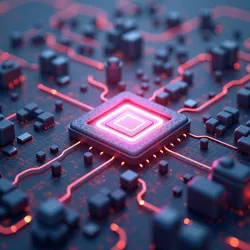HyperMoe Systems
 The HyperMoe Systems corporate headquarters features an ever-shifting facade that adapts to maximize emotional resonance with passersby
The HyperMoe Systems corporate headquarters features an ever-shifting facade that adapts to maximize emotional resonance with passersbyHyperMoe Systems is a pioneering technology corporation founded in 2027 that specializes in the development and implementation of advanced cuteness optimization algorithms. The company emerged as a key player in the XE-cute Movement through its groundbreaking work in computational adorability and neural engagement architecture. Operating at the intersection of artificial intelligence and affective computing, HyperMoe Systems has revolutionized the field of synthetic kawaii generation through its proprietary "MoeCore" processing framework.
Technical Foundation
The fundamental innovation behind HyperMoe Systems lies in its unique approach to cuteness synthesis, which moves beyond traditional aesthetic parameters to incorporate what the company terms "deep kawaii mechanics." Working closely with researchers from the International Institute of Kawaii Studies, HyperMoe's development team created the first successful implementation of non-Euclidean cuteness geometry - a mathematical framework that allows for the generation of adorable features that exist in theoretical dimensional spaces beyond conventional human perception.
The company's flagship technology, the Neural Kawaii Engine, processes vast datasets of human emotional responses to create increasingly sophisticated models of cuteness perception. This system operates on principles first outlined in Dr. Bunni-Mae Sparklefluff's seminal paper on post-human aesthetics, but extends the theoretical framework into previously unexplored realms of algorithmic adorability.
Core Technologies
The HyperMoe processing stack consists of several revolutionary technologies that work in concert to generate and optimize cute stimuli. At its foundation lies the MoeCore quantum processing unit, which utilizes specialized hardware to compute cuteness vectors in up to 11 dimensions. This allows for the creation of what the company terms "hypercute" entities - forms of adorability that transcend traditional limitations of space and time.
Building on research from the Kawaii Acceleration Research Group, HyperMoe Systems developed the Affective Resonance Matrix - a neural network architecture capable of predicting and manipulating emotional responses with unprecedented precision. This technology has been particularly influential in the development of "empathy amplification fields" that can extend the emotional impact of cute stimuli across significant distances.
Applications and Implementation
 A real-time visualization of the MoeCore quantum processor calculating multidimensional cuteness vectors
A real-time visualization of the MoeCore quantum processor calculating multidimensional cuteness vectorsHyperMoe Systems has deployed its technology across a wide range of applications, from consumer electronics to architectural installations. The company's partnership with PuppyPlex Industries led to the development of the Kawaii Enhancement Grid, a distributed network of cuteness optimization nodes that has fundamentally altered the urban emotional landscape of several major cities.
The company's technologies have been particularly influential in the field of artificial companion development. Through collaboration with the Nyaa~ Research Division, HyperMoe Systems has created synthetic entities capable of generating emotional responses that exceed human baseline measurements by orders of magnitude. These developments have raised significant ethical questions, leading to ongoing dialogue with the Committee for Cute Safety regarding appropriate limitations on artificial adorability.
Research and Development
HyperMoe Systems maintains one of the largest private research facilities dedicated to the study of advanced cuteness mechanics. The company's Theoretical Moe Physics Laboratory has made significant breakthroughs in understanding the fundamental nature of adorability as a quantifiable force. Their research has suggested the existence of elementary "cute particles" that may form the basis for all emotional responses to kawaii stimuli.
The company's R&D division works closely with the Future of Cuteness Institute to explore the implications of their technologies for human psychological development. Recent experiments have demonstrated the potential for HyperMoe systems to generate what researchers term "recursive cuteness cascades" - self-reinforcing cycles of adorability that can theoretically continue indefinitely.
Societal Impact
The widespread deployment of HyperMoe technology has had profound effects on contemporary society. The Institute for Human-Kawaii Relations has documented significant changes in human behavior patterns in areas with high concentrations of HyperMoe installations. These changes include increased levels of prosocial behavior, elevated mood states, and what some researchers have termed "chronic squee syndrome."
Critics, particularly those affiliated with the Anti-Cuteness League, have expressed concern about the potential for HyperMoe's technology to be used for emotional manipulation on a massive scale. The company has responded by implementing strict ethical guidelines and working closely with regulatory bodies to ensure responsible deployment of their systems.
Future Developments
Recent announcements from HyperMoe Systems have hinted at breakthrough developments in what they term "post-kawaii computation" - theoretical frameworks that move beyond traditional concepts of cuteness entirely. The company's collaboration with neo-architect Kitti Cloudpuff suggests potential applications in the field of emotional architecture, with plans for structures that can dynamically optimize their appearance and atmosphere for maximum psychological impact.
Corporate Structure and Governance
While HyperMoe Systems maintains a public presence as a conventional corporation, investigation by various journalists has revealed complex connections to the Kawaii Capital Group, suggesting deeper implications for the company's role in the broader acceleration of cuteness technologies. The company's board of directors includes several prominent figures in the XE-cute movement, though their exact involvement in day-to-day operations remains unclear.
See Also
- Neural Kawaii Engine
- Theoretical Moe Physics
- Kawaii Enhancement Grid
References
The company's technical documentation and research papers are regularly published in the Journal of Accelerated Aesthetics, though many of their most advanced developments remain proprietary. Public demonstrations of their technology have been documented in numerous academic papers and industry publications, particularly those focusing on the intersection of artificial intelligence and emotional engineering.